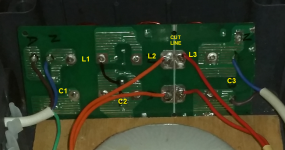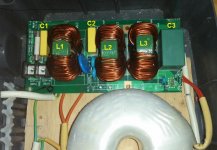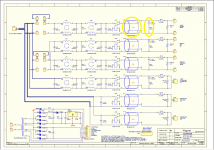Thanks for your reply.
Allow me to add that, according to UK standards, the tripping characteristics of RCDs of 30mA or less provide protection against ventricular fibrillation by disconnecting from the supply within 40ms.
Allow me to add that, according to UK standards, the tripping characteristics of RCDs of 30mA or less provide protection against ventricular fibrillation by disconnecting from the supply within 40ms.
An American researcher named Charles Dalziel performed experiments with both human and animal subjects to determine the effects of electric currents on the body. A table showing his research data is presented here:
http://www.wright.edu/~guy.vandegrift/wikifiles/Electric Shock Hazard Dalziel.pdf
[GFCI in USA now trip at 4-5 mA in 1/40 sec.]
Whether a danger or not has to be measured in your situation. However, clearly if you have hum/buzz it can be hard to get rid of in many systems. Changes in grounding systems in use and practice and leakage currents can be higher than assumed in many cases and hard to remove. In USA home ac power wiring is best reason for optional BAL signal I/O.
-RNM
http://www.wright.edu/~guy.vandegrift/wikifiles/Electric Shock Hazard Dalziel.pdf
[GFCI in USA now trip at 4-5 mA in 1/40 sec.]
Whether a danger or not has to be measured in your situation. However, clearly if you have hum/buzz it can be hard to get rid of in many systems. Changes in grounding systems in use and practice and leakage currents can be higher than assumed in many cases and hard to remove. In USA home ac power wiring is best reason for optional BAL signal I/O.
-RNM
Last edited:
Quote:""The maximum uninterrupted reasonably safe currents are taken as the 0.5 percentile values, or 9 mA for normal men and 6 mA for normal women. So far, it has been impossible to obtain reliable values for chidren; they just cry at the higher values.""
WHAT??? CHILDREN? SERIOUSLY???
That article is from 1972, I have his original research paper from Geneva 1961. It has that same guy cringing, I cringe just seeing it. In the original, there is another pic of a guy grimacing as well, and you can see the researcher holding his left hand on the wet electrode on the desk..I do not know which is more disturbing, seeing the guy grimacing in pain, or seeing the researchers face with a big smile on it..
I also found stuff on animal studies (dogs IIRC), where they determine the fibrillation numbers. sometimes they lost a subject that could not be revived using the then-being-developed defibrillator.
For death as well as let-go, there is significant correlation between body weight and sensitivity.
His '61 paper has significantly more data.
jn
WHAT??? CHILDREN? SERIOUSLY???
That article is from 1972, I have his original research paper from Geneva 1961. It has that same guy cringing, I cringe just seeing it. In the original, there is another pic of a guy grimacing as well, and you can see the researcher holding his left hand on the wet electrode on the desk..I do not know which is more disturbing, seeing the guy grimacing in pain, or seeing the researchers face with a big smile on it..
I also found stuff on animal studies (dogs IIRC), where they determine the fibrillation numbers. sometimes they lost a subject that could not be revived using the then-being-developed defibrillator.
For death as well as let-go, there is significant correlation between body weight and sensitivity.
His '61 paper has significantly more data.
jn
Last edited:
Some people measure their bioelectrical impedance regularly as part of their keep fat routine! 🙂
At last a reason to be fat!
Condolences JN.
Thanks..
Hey, you near Youngwood?
jn
WHAT??? CHILDREN? SERIOUSLY???
Well at least it wasn't like Pavlov...
I have this abomination in an apartment in France. Sockets are daisy chained up to 8 and not organized circuit per room.That isn't normal for UK where you should have a ring-main in each room, which brings its own issues with Maximising loop area.
But of course there are still various abominations that people have snuck in before laws changed.
Organized for minimum lenght of wires. So a room can have sockets on different circuits, as well as some circuit feeding different rooms.
This is compliant with 1974 rules
In the most recent rules: No daisy chaining. All sockets with ground wire.
With all the rules, the main electric panel looks like a 747 instrument cockpit.
...
Organized for minimum lenght of wires. So a room can have sockets on different circuits, as well as some circuit feeding different rooms.
This is compliant with 1974 rules
...
Yes: at that time, in Switzerland, in order to answer an request for proposal, the bidders would measure the distances on the blueprint and apply a cost per meter. Of course, the bidders with lower costs have a better chance of winning. And you don't want to change anything after you poured concrete over it.
Thanks..
Hey, you near Youngwood?
jn
Under an hour drive time. Two days walking.
Under an hour drive time. Two days walking.
Checked Google. 32 miles.
I may have a multi-year contract with a vendor there. If so, we will have to have dinner, if only for you to slap me in the face in person...😀
Demian will pay the bill...😱
Jn
Small world. I need a whole lot of 7000 amp diodes.
Jn
I take it the normal 10,000 amp ones won't work. 😉
Hi Richard.
I have constructed an AC filter/screened isolation transformer box for purpose of isolating my music source laptop (and usb DAC) which runs on ext brick SMPS....which causes longitudinal leakage/noise (as expected).
The resultant is cleaner/clearer system with fine film/haze removed from the sound and pretty much the same sound as when the laptop is running on internal batteries, but not exactly the same, ie powering the laptop ext smps still causes a very slight sonic change.
The circuit is as below...



The filter pcb is a section cutout from a salvaged solar convertor pcb.
I cut the pad (-x- on the schematic) connecting L2 and L3 and inserted the isolation transformer at these connections.
Do you advise shunt caps or RC networks across L2/primary or L3/secondary and RC network across final output?.
Destroyer OS in his Felix AC filter recommended 3K resistors in parallel with each of the the CM choke windings....do you have opinion/experience with this?.

In your HTPS schematic I notice there are 0.1uf/1R5 RC networks across the filtered direct AC outputs, but not across the transformer isolated outputs.....is there particular reason for this?.
Thanks, Dan.
I have constructed an AC filter/screened isolation transformer box for purpose of isolating my music source laptop (and usb DAC) which runs on ext brick SMPS....which causes longitudinal leakage/noise (as expected).
The resultant is cleaner/clearer system with fine film/haze removed from the sound and pretty much the same sound as when the laptop is running on internal batteries, but not exactly the same, ie powering the laptop ext smps still causes a very slight sonic change.
The circuit is as below...



The filter pcb is a section cutout from a salvaged solar convertor pcb.
I cut the pad (-x- on the schematic) connecting L2 and L3 and inserted the isolation transformer at these connections.
Do you advise shunt caps or RC networks across L2/primary or L3/secondary and RC network across final output?.
Destroyer OS in his Felix AC filter recommended 3K resistors in parallel with each of the the CM choke windings....do you have opinion/experience with this?.

In your HTPS schematic I notice there are 0.1uf/1R5 RC networks across the filtered direct AC outputs, but not across the transformer isolated outputs.....is there particular reason for this?.
Thanks, Dan.
Last edited:
😀I take it the normal 10,000 amp ones won't work. 😉
Room temperature perhaps. Not at 4.5 Kelvin.
And space is at a premium, so it's a custom job. Hockey pucks require external compression hardware, and we have to go 12 thousand lbs force, normal is 9 thousand.
Jn
Hi Richard.
I have constructed an AC filter/screened isolation transformer box for purpose of isolating my music source laptop (and usb DAC) which runs on ext brick SMPS....which causes longitudinal leakage/noise (as expected).
The resultant is cleaner/clearer system with fine film/haze removed from the sound and pretty much the same sound as when the laptop is running on internal batteries, but not exactly the same, ie powering the laptop ext smps still causes a very slight sonic change.
Do you advise shunt caps or RC networks across L2/primary or L3/secondary and RC network across final output?.
Destroyer OS in his Felix AC filter recommended 3K resistors in parallel with each of the the CM choke windings....do you have opinion/experience with this?.
View attachment 796029
In your HTPS schematic I notice there are 0.1uf/1R5 RC networks across the filtered direct AC outputs, but not across the transformer isolated outputs.....is there particular reason for this?.
Thanks, Dan.
Do you have a network analyzer to view the filter performance? Some of the values depend on the inductor/CM characteristics vs freq.
THx-RNMarsh
Last edited:
Do you have a network analyzer to view the filter performance?
Yes, it is between his ears. Unfortunately not the best (to stay civil) around.
No I don't have a network analyser, perhaps I can record speaker outputs and see if I can detect differences and compare that way.Do you have a network analyzer to view the filter performance? Some of the values depend on the inductor/CM characteristics vs freq.
I do have a couple of sensing current transformers, perhaps this might be a way of recording/listening to audio band mains noise....anybody have experience with this ?.
How about using one winding of a CM choke as a series inductor and the other winding as current sensing winding ?.
Last edited:
😀
Room temperature perhaps. Not at 4.5 Kelvin.
And space is at a premium, so it's a custom job. Hockey pucks require external compression hardware, and we have to go 12 thousand lbs force, normal is 9 thousand.
Jn
What voltage drop do you expect from the chilling out semiconductors? Seems it is gonna be tough for them to keep their cool. Ever look at germanium? 😉
- Status
- Not open for further replies.
- Home
- Member Areas
- The Lounge
- John Curl's Blowtorch preamplifier part III